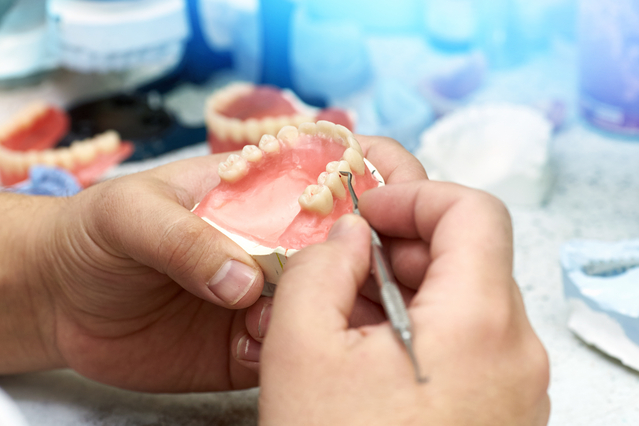Prosthetic care in dentistry includes various approaches and techniques to restore missing teeth and jaw structures. These range from fixed to removable solutions and combined methods to maximize functionality, aesthetics and comfort for the patient.
Fixed prosthetics:
This type of prosthetics refers to dentures that are permanently fixed in the mouth and cannot be removed by the patient.
Crown:
Materials: Crowns can be made from a variety of materials, including composite, ceramic, metal alloys, or a combination of these. The choice of material depends on several factors, such as the position of the tooth in the mouth, aesthetic considerations, and chewing force .
Areas of application: They are used to restore damaged or severely carious teeth, to maintain the shape and function of a tooth after root canal treatment or as part of a bridge or implant.
Manufacturing process: The production of a crown usually begins with the preparation of the affected tooth, followed by taking an impression. Modern CAD/CAM technologies now enable crowns to be manufactured more precisely and quickly.
Bridges:
Design: Bridges consist of two or more crowns that span adjacent teeth, with one or more artificial teeth in between.
Biomechanical aspects: They must be designed to withstand the chewing forces while exerting an even load on the abutment teeth.
Patient comfort: In addition to functionality, patient comfort is also crucial, especially in terms of fit and feel in the mouth.
Implants:
Integration into the jawbone: Implants are artificial tooth roots that are inserted into the jawbone. They integrate with the bone through osseointegration and form a stable base for the dentures attached to them.
Long-term success: Implants have a high success rate and can last a lifetime with proper care and regular check-ups.
Removable prosthetics:
This category includes prostheses that can be removed by the patient and are used particularly in cases of extensive tooth loss.
Partial dentures:
Design options: Partial dentures can be made from different materials such as acrylic or metal and can be attached to the remaining teeth with clasps or other retaining elements.
Anchoring systems: They can be attached to the remaining natural teeth using brackets, attachments or telescopes.
Full dentures:
Adaptation to the oral mucosa: Full dentures must be carefully adapted to the shape of the oral mucosa and jaw to ensure comfort and functionality.
Aesthetics: Aesthetics plays an important role, especially in the design of the visible tooth area.
Combined prosthetics:
This uses a combination of fixed and removable prostheses. This offers flexibility and can be used in complex cases to take advantage of the benefits of both methods.
Combination of fixed and removable dentures: Such solutions are often necessary when certain conditions in the patient's mouth do not allow for purely fixed or removable prosthetics.
This variety of prosthetic solutions offers individual treatment options tailored to the specific needs and expectations of each patient. The selection of the appropriate prosthetic approach depends on various factors, such as the extent of tooth loss, the health of the surrounding tissue, the aesthetic requirements and, last but not least, the patient's personal preferences. With the ongoing development of new materials and techniques, the spectrum of prosthetic care is constantly expanding in order to achieve optimal functional and aesthetic results and thus improve the quality of life of patients.
